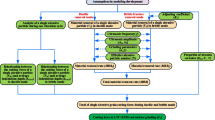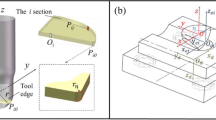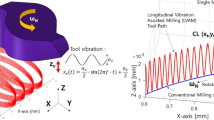Abstract
Cutting force plays an important role in the design of cutting plans, setting of cutting conditions, inspection of tool wear, and prediction of machined surface topography. As no previous research has focused on cutting force in ultra-precision raster milling (UPRM), this paper presents a theoretical and experimental study on cutting force modeling in UPRM of V-groove. An analytic cutting force model is established to predict the cutting force components both in the feed direction and thrust direction, and a dynamic model is developed to simulate the free vibration signal induced by the cutting force pulse. The effects of cutting parameters in UPRM are studied, including the depth of cut and feed rate, and a group of experiments conducted to verify the simulation results. The simulation and experimental results show that cutting force in UPRM is figured as a force pulse followed by a free vibration signal induced by the force pulse and that the amplitudes of cutting force in both feed direction and thrust direction increase with the growing depth of cut and feed rate.
Similar content being viewed by others
References
Merchant ME (1945) Mechanics of the metal cutting process. I: orthogonal cutting and a type 2 chip. J Appl Phys 16(5):267–275
Lo-A-Foe TCG, Dautzenberg JH, Van Der Wolf ACH (1988) Cutting forces and their influences upon the surface integrity in single-point diamond turning. In Proceedings of the International Congress for Ultraprecision Technology, Tokyo, Japan, pp 110–125
Drescher JD (1992) Tool force, tool edge and surface finish relationships in diamond turning. PhD Dissertation, North Carolina State University
Wang HX, Sun T, Li D (2004) Tool force model for diamond turning. Chin J Mech Eng 17:145–148
Heamawatanachai S, Bamberg E (2010) Cutting force model of orbital single-point micromachining tool. Int J Mach Tool Manuf 50:815–823
Li BL, Wang XL, Hu YJ, Li CG (2011) Analytical prediction of cutting forces in orthogonal cutting using unequal division shear-zone model. Int J Adv Manuf Technol 54(5–8):431–443
Arif M, Rahman M, San WY (2011) Analytical modeling of ductile-regime machining of tungsten carbide by endmilling. Int J Adv Manuf Technol 55(1–4):53–64
Zaman MT, Kumar AS, Rahman M, Sreeram S (2006) A three-dimensional analytical cutting force model for micro end milling operation. Int J Mach Tool Manuf 46:353–366
Martellotti ME (1941) An analysis of the milling process. Trans ASME 63:677–700
Tlusty J, Macneil P (1975) Dynamics of cutting forces in end milling. Ann CIRP 24:21–25
Kang IS, Kim JS, Seo YW (2008) Cutting force model considering tool edge geometry for micro end milling process. J Mech Sci Technol 22(2):293–299
Dow TA, Miller EL, Garrard K (2004) Tool force and deflection compensation for small milling tools. Precis Eng 28:31–45
Kang IS, Kim JS, Kim JH (2007) A mechanistic model of cutting force in the micro end milling process. J Mater Process Technol 187–188:250–255
Fontaine M, Devillez A, Moufki A, Dudzinski D (2006) Predictive force model for ball-end milling and experimental validation with a wavelike form machining test. Int J Mach Tool Manuf 46:367–380
Wei ZC, Wang MJ, Zhu JN, Gu LY (2011) Cutting force prediction in ball end milling of sculptured surface with Z-level contouring tool path. Int J Mach Tool Manuf 51:428–432
Wang SJ, To S, Chan CY, Cheung CF, Lee WB (2010) A study of the cutting-induced heating effect on the machined surface in ultra-precision raster milling of 6061 Al alloy. Int J Adv Manuf Technol 51(1–4):69–78
Wang SJ, To S, Cheung CF (2013) An investigation into material-induced surface roughness in ultra-precision milling. Int J Adv Manuf Technol 68:607–616
Zhang GQ, To S, Xiao GB (2014) A novel spindle inclination error identification and compensation method in ultra-precision raster milling. Int J Mach Tool Manuf 78:8–17
Yin ZQ, To S, Lee WB (2009) Wear characteristics of diamond tool in ultra-precision raster milling. Int J Adv Manuf Technol 44(7–8):638–647
Zhang GQ, To S, Xiao GB (2014) The relation between chip morphology and tool wear in ultra-precision raster milling. Int J Mach Tool Manuf 80–81:11–17
Zhang GQ, To S, Xiao GB (2014) Novel tool wear monitoring method in ultra-precision raster milling using cutting chips. Precis Eng 38(3):555–560
Arcona C, Dow TA (1998) An empirical tool force model for precision machining. Manuf Sci Eng 120(4):700–707
Author information
Authors and Affiliations
Corresponding author
Rights and permissions
About this article
Cite this article
To, S., Zhang, G. Study of cutting force in ultra-precision raster milling of V-groove. Int J Adv Manuf Technol 75, 967–978 (2014). https://doi.org/10.1007/s00170-014-6200-1
Received:
Accepted:
Published:
Issue Date:
DOI: https://doi.org/10.1007/s00170-014-6200-1




